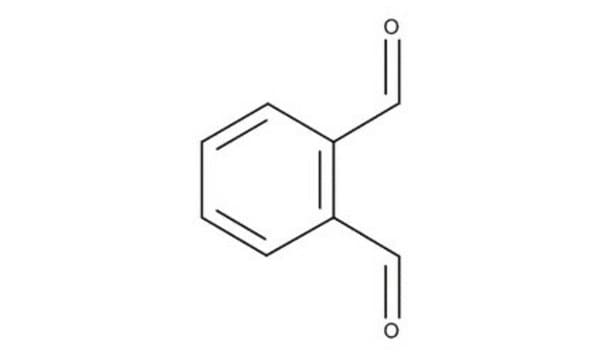1.11452
Phthaldialdehyde
for fluorometry
Synonim(y):
Phthaldialdehyde, OPA
About This Item
Polecane produkty
Poziom jakości
Postać
solid
temp. samozapłonu
480 °C
siła działania
178 mg/kg LD50, oral (Rat)
>2000 mg/kg LD50, skin (Rat)
pH
7 (20 °C, 53 g/L in H2O)
tw
83-84 °C/1 hPa
mp
52-58 °C
temp. przejścia
flash point 132 °C
rozpuszczalność
53 g/L
gęstość
1.13 g/cm3 at 20 °C
gęstość nasypowa
530 kg/m3
temp. przechowywania
2-30°C
InChI
1S/C8H6O2/c9-5-7-3-1-2-4-8(7)6-10/h1-6H
Klucz InChI
ZWLUXSQADUDCSB-UHFFFAOYSA-N
Zastosowanie
- Combined techniques for revealing the mechanism beneath the inhibition effects of pectin on gluten digestibility using static in vitro gastro-duodenal protocols.: This study uses a combination of techniques to explore how pectin affects gluten digestibility, providing insights into the interaction of phthaldialdehyde derivatives with gluten proteins (Lin et al., 2024).
- Analysis of Gizzerosine in Foodstuffs by HPLC Involving Pre-column Derivatization with o-Phthaldialdehyde.: This research develops a method using HPLC with pre-column derivatization involving phthaldialdehyde to analyze gizzerosine in foodstuffs, demonstrating the compound′s utility in food safety studies (Li and Wu, 2024).
- Comprehensive studies on the development of HPLC-MS/MS and HPLC-FL based methods for routine determination of homocysteine thiolactone in human urine.: This study develops and validates methods using phthaldialdehyde derivatives for the determination of homocysteine thiolactone in human urine, contributing to clinical diagnostics and biochemical research (Piechocka and Głowacki, 2024).
- Smart-detection approach for protein residues to evaluate the cleaning efficacy of reusable medical devices.: Utilizing phthaldialdehyde for protein residue detection, this study provides a smart detection approach to improve the cleaning efficacy of medical devices, enhancing patient safety (Ouirungroj et al., 2024).
- One-pot sample preparation procedure for the determination of protein N-linked homocysteine by HPLC-FLD based method.: This research presents a novel one-pot sample preparation method using phthaldialdehyde for determining protein N-linked homocysteine, advancing analytical techniques in protein chemistry (Piechocka and Głowacki, 2023).
Komentarz do analizy
Identity (IR): conforms
Melting point: 54 - 58 °C
Fluorescence (340 nm, 0,8 g/l, ethanol, as quinine): ≤ 2 ppb
Phthalic acid (TLC): ≤ 0.5 %
Nitrogen compounds (as N): ≤ 0.05 %
Hasło ostrzegawcze
Danger
Zwroty wskazujące rodzaj zagrożenia
Zwroty wskazujące środki ostrożności
Klasyfikacja zagrożeń
Acute Tox. 3 Oral - Aquatic Acute 1 - Aquatic Chronic 1 - Eye Dam. 1 - Skin Corr. 1B - Skin Sens. 1 - STOT SE 3
Organy docelowe
Respiratory system
Kod klasy składowania
6.1A - Combustible, acute toxic Cat. 1 and 2 / very toxic hazardous materials
Klasa zagrożenia wodnego (WGK)
WGK 3
Temperatura zapłonu (°F)
269.6 °F - closed cup
Temperatura zapłonu (°C)
132 °C - closed cup
Certyfikaty analizy (CoA)
Poszukaj Certyfikaty analizy (CoA), wpisując numer partii/serii produktów. Numery serii i partii można znaleźć na etykiecie produktu po słowach „seria” lub „partia”.
Masz już ten produkt?
Dokumenty związane z niedawno zakupionymi produktami zostały zamieszczone w Bibliotece dokumentów.
Klienci oglądali również te produkty
Nasz zespół naukowców ma doświadczenie we wszystkich obszarach badań, w tym w naukach przyrodniczych, materiałoznawstwie, syntezie chemicznej, chromatografii, analityce i wielu innych dziedzinach.
Skontaktuj się z zespołem ds. pomocy technicznej








